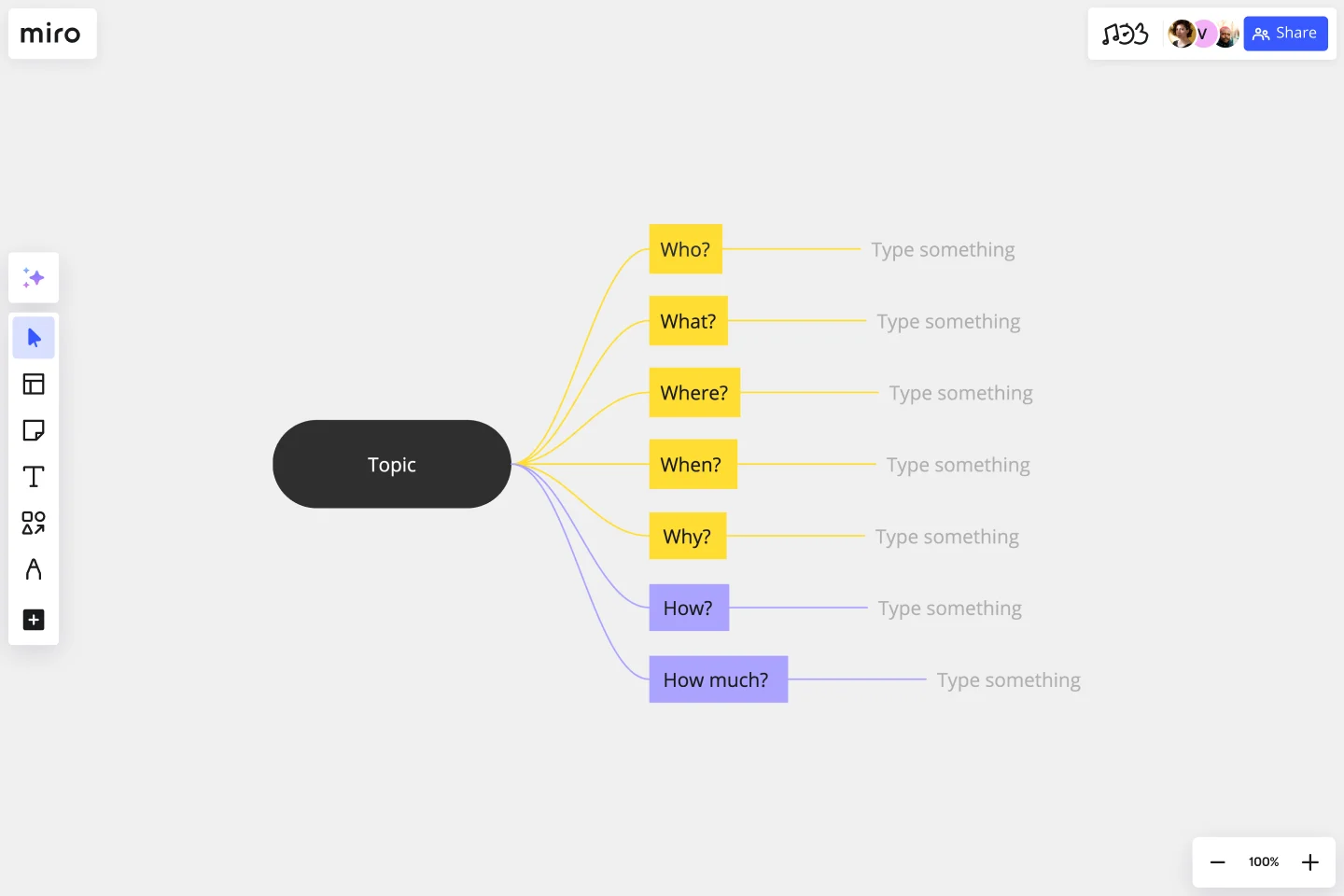5W2H Template
Explore a structured approach to project management addressing the who, what, when, where, why, how, and how much with the 5W2H template.
About the 5W2H Template
The 5W2H framework is a valuable tool that can help you streamline your thought process and improve your project management skills. This structured approach involves answering seven questions that can help you gather and organize information effectively.
The questions are: Who, What, When, Where, Why, How, and How Much. You can make informed decisions and achieve better outcomes by examining a situation comprehensively.
What: Identify the core task or issue.
Why: Understand the purpose or motive behind it.
Who: Pinpoint the people or teams involved.
When: Establish the timeline and deadlines.
Where: Specify the location or context.
How: Explore the methods or processes.
How Much: Determine the resources or quantities involved.
This template is a guiding framework, ensuring no crucial aspect is overlooked.
How to use the 5W2H Template in Miro
Edit easily: Customize the template effortlessly by filling in relevant details or changing the questions.
Expand with a click: Effortlessly expand the template to explore details with a single click, providing a deeper dive into each element.
Add contextual artifacts: Enhance your board by incorporating documents, images, or other artifacts that provide additional context to your 5W2H analysis.
Why should you use a 5W2H Template?
1. Clarity and focus: The template provides a structured approach, helping teams clarify objectives and focus on key aspects.
2. Efficient problem solving: the 5W2H template facilitates thorough problem analysis and effective solutions by addressing all relevant questions.
3. Improved communication: Enhance communication within teams by ensuring that everyone is on the same page regarding project details.
4. Time management: Clearly defined timelines and deadlines ensure better time management, reducing delays and improving project efficiency.
5. Comprehensive understanding: The template encourages a thorough understanding of a situation, minimizing the risk of overlooking critical details.
Is the 5W2H template suitable for all types of projects?
Yes, the template's versatility makes it applicable to various projects, from simple tasks to complex problem-solving scenarios.
How can I get all crucial information when using the template?
The structured nature of the 5W2H template guides you through each essential question, reducing the likelihood of overlooking key details.
Get started with this template right now.
Project Proposal Template
Works best for:
Project Management, Documentation, Project Planning
For any type of project, the Project Proposal template can be a crucial step toward clarifying the context, goals, and scope of a project to get stakeholder buy-in. A project proposal outlines what you want to accomplish, your goals, and how you plan to achieve them. Generally, a project proposal gives the reader some context on the project, explains why it is important, and lists the actions that you will take to complete it. Project proposals have myriad uses. Often, businesses use project proposals to get external buy-in from a donor or outside stakeholder. But many companies draw up project proposals for internal buy-in too.
PI Planning Template
Works best for:
PI Planning, Product Management
The Miro PI Planning Template streamlines the Program Increment planning process for Agile teams. It facilitates a collaborative environment, enabling teams to efficiently align on strategies, identify dependencies, and convert decisions into actionable tasks. With features like real-time collaboration, Jira integration, and a centralized workspace, the template supports teams in enhancing efficiency, engagement, and decision-making.
Fishbone Diagram by Dave Westgarth
Works best for:
Fishbone diagram
Identify and solve problems effectively with the Fishbone Diagram by Dave Westgarth. This template helps you break down complex issues into root causes, enabling a thorough analysis and targeted solutions. Use it for quality control, process improvement, and troubleshooting in various industries. Ideal for teams focused on continuous improvement and problem-solving.
Entity Relationship Diagram Template
Works best for:
Flowcharts, Strategic Planning, Diagrams
Sometimes the most important relationships in business are the internal ones—between the teams, entities, and actors within a system. An entity relationship diagram (ERD) is a structural diagram that will help you visualize and understand the many complex connections between different roles. When will an ERD come in handy? It’s a great tool to have for educating and onboarding new employees or members of a team, and our template makes it so easy to customize according to your unique needs.
Checklist Template
Works best for:
Project Management, Task Management
The Checklist Template is designed to organize and track tasks visually, offering workflow clarity. A key benefit of using this template is its potential to amplify collaboration, ensuring that all team members remain aligned and informed, paving the way for efficient project completion.
Company Organization Chart
Works best for:
Org Charts, Operations, Mapping
The Company Organization Chart template enables clear visualization of hierarchical structures within an organization. It helps teams understand reporting lines, roles, and responsibilities, fostering transparency and alignment. With customizable features, such as color-coding and labeling, this template facilitates effective communication and decision-making across departments and levels.
